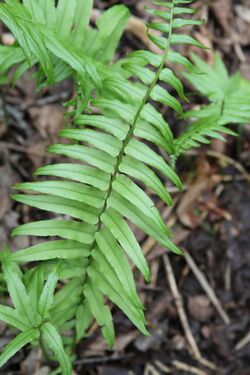Biology:Diplaziopsidaceae
| Diplaziopsidaceae | |
|---|---|

| |
| Homalosorus pycnocarpos | |
| Scientific classification | |
| Kingdom: | Plantae |
| Clade: | Tracheophytes |
| Division: | Polypodiophyta |
| Class: | Polypodiopsida |
| Order: | Polypodiales |
| Suborder: | Aspleniineae |
| Family: | Diplaziopsidaceae X.C.Zhang & Christenh. |
| Genera | |
|
See text | |
| Synonyms[1] | |
| |
Diplaziopsidaceae is a family of ferns in the order Polypodiales. In the Pteridophyte Phylogeny Group classification of 2016 (PPG I), the family is placed in the suborder Aspleniineae, and includes two genera.[2] Alternatively, it may be treated as the subfamily Diplaziopsidoideae of a very broadly defined family Aspleniaceae.[1]
They are described as medium-to-large ferns, which grow near streams in forested areas. Their rhizomes are thick and decumbent to erect.[3] Species are found in east Asia, from China south to New Guinea and east into the Pacific.[4]
Taxonomy
Maarten J. M. Christenhusz and Xuan-Chun Zhang originally described the family in 2011 by including three genera Diplaziopsis, Hemidictyum, and Homalosorus.[3] Later that year Samuli Lehtonen found Hemidictyum to be a sister to Aspleniaceae,[5] so Hemidictyum was placed in its own family, Hemidictyaceae.[6] Christenhusz and Mark W. Chase later included Hemidictyum in their subfamily Asplenioideae rather than their subfamily Diplaziopsidoideae.[1]
Genera
Two genera are accepted in the PPG I classification, and by the Checklist of Ferns and Lycophytes of the World (As of November 2019):[2][4]
- Diplaziopsis C.Chr. – three species
- Homalosorus Small ex Pic. Serm. – one species
Phylogenetic relationships
The following cladogram for the suborder Aspleniineae (as eupolypods II), based on Lehtonen, 2011,[5] and Rothfels & al., 2012,[7] shows a likely phylogenetic relationship between the Diplaziopsidaceae and the other families of the clade.
References
- ↑ 1.0 1.1 1.2 Christenhusz, Maarten J.M.; Chase, Mark W. (2014). "Trends and concepts in fern classification". Annals of Botany 113 (9): 571–594. doi:10.1093/aob/mct299. PMID 24532607.
- ↑ 2.0 2.1 PPG I (2016). "A community-derived classification for extant lycophytes and ferns". Journal of Systematics and Evolution 54 (6): 563–603. doi:10.1111/jse.12229.
- ↑ 3.0 3.1 Maarten J. M. Christenhusz; Xian-Chun Zhang; Harald Schneider (2011). "A linear sequence of extant families and genera of lycophytes and ferns". Phytotaxa 19: 7–54. doi:10.11646/phytotaxa.19.1.2. http://www.mapress.com/phytotaxa/content/2011/f/pt00019p054.pdf.
- ↑ 4.0 4.1 Hassler, Michael; Schmitt, Bernd (November 2019), "Diplaziopsidaceae", Checklist of Ferns and Lycophytes of the World, 8.11, https://worldplants.webarchiv.kit.edu/ferns/, retrieved 2019-11-27
- ↑ 5.0 5.1 Samuli Lehtonen (2011). "Towards Resolving the Complete Fern Tree of Life". PLOS ONE 6 (10): e24851. doi:10.1371/journal.pone.0024851. PMID 22022365. PMC 3192703. http://www.sci.utu.fi/sivustot/amazon/publications/articles/pdf_pub/Lehtonen_2011_PLoS1.pdf.
- ↑ Maarten J. M. Christenhusz; Harald Schneider (2011). "Corrections to Phytotaxa 19: Linear sequence of lycophytes and ferns". Phytotaxa 28: 50–52. doi:10.11646/phytotaxa.28.1.6. http://www.mapress.com/phytotaxa/content/2011/f/pt00028p052.pdf.
- ↑ Carl J. Rothfels; Anders Larsson; Li-Yaung Kuo; Petra Korall; Wen- Liang Chiou; Kathleen M. Pryer (2012). "Overcoming Deep Roots, Fast Rates, and Short Internodes to Resolve the Ancient Rapid Radiation of Eupolypod II Ferns". Systematic Biology 61 (1): 490–509. doi:10.1093/sysbio/sys001. PMID 22223449.
Wikidata ☰ Q2014294 entry
 |

